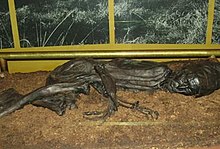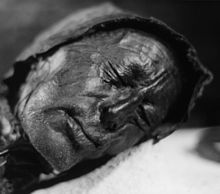Tollund man
The Tollund Man (also Tollundmanden ; Danish Tollundmanden ) is on 6 May 1950 in a bog in Bjældskovdal , ten kilometers west of Silkeborg in Denmark discovered by peat cutters bog body . It is now on display in the Silkeborg Museum.
Finding circumstances
While the brothers Viggo and Emil Højgaard were digging peat in Bjældskovdal on May 6, 1950, a Saturday, Viggo's wife Grethe discovered a human body in a peat pit at a depth of 2.50 m that was so well preserved that she made it a contemporary one Murder victims stopped. The following Monday they informed the police in Silkeborg. On the advice of the consulted archaeologist Peter Vilhelm Glob from Aarhus University , who estimated the age of the corpse to be around 2000 years, a wooden box was built around it and transported by horse-drawn carriage and train to the Danish National Museum in Copenhagen for further investigation . The curator Knud Thorvildsen (1907–1987), who had already recovered the bog bodies from Borremose, was commissioned with the excavation of the Tollund man from the peat block . The corpse was cleared of peat, extensively photographed, x-rayed in the Bispebjerg hospital and finally autopsied. It was decided to preserve the head of the Tollund man with the perfectly preserved facial features.
Location: 56 ° 9 '53.3 " N , 9 ° 23' 34.7" O .
description
The Tollund man lay relaxed on his right side, his legs drawn to his stomach. With the exception of a sheepskin cap sewn together from eight pieces and a 77 cm long leather belt, he wore no clothing. It is possible that he was originally dressed in textiles made from vegetable fibers such as flax , hemp or nettles, which had been decomposed by the acidic environment in the moor. Its age was estimated to be around 40 years. At 161 cm it was rather small, but probably also shrunk in the bog so that the skin was wrinkled. His arms and hands were damaged while cutting peat, but his feet and one of the fingers were well preserved. The papillary lines and skin line patterns on the soles of the feet were no different from those of today's people. The head was particularly well preserved. The expression was calm, mouth and eyes closed, and gave the impression of a sleeping person. He looked well-groomed. His hair was cut short and 2 to 3 cm long. The leather cap that covered the hair of his head was fastened with two leather strips under his chin. The neck of the bog body was in a braided leather loop that had left clear marks in the skin on the sides and under the chin. The free end of the strap, located under the body, was about three feet long and cut off at the end. Most of the upper body was still covered by skin. The left side of the chest and shoulder in particular were poorly preserved and some of them had worn off. The genitals were well preserved, as were the internal organs such as the heart, lungs and liver. The remains of his last meal were still found in the stomach, small intestine and large intestine of the Tollund man.
Findings
More recent radiocarbon dates indicate a probable period of death from 405–380 BC. BC, which falls into the pre-Roman Iron Age .
The pollen analysis of his well-preserved stomach and intestinal contents revealed the season of his death to be late winter or early spring. The stomach contents, consisting of a porridge or a grits made exclusively from plant seeds (especially barley , flax , camelina and knotweed ), suggests that the Tollund man had a last meal a few hours before his death. The fact that it contained up to 40 different plant seeds, some of which were only found in very specific areas, has led to the assumption that it was a special food reserved for rituals. Isotope studies on bone collagen in the Tollund man have shown that his food mainly consisted of vegetable products from fertilized fields during his lifetime . It could be ruled out that the man ate sea fish.
The examination of the Tollund man for diseases did not yield any results. However, eggs of the whipworm ( Trichuris trichiura ), a parasitic roundworm , were found in his intestines .
The noose still around his neck suggests the Tollund man's violent death by strangulation , although the doctor who performed the forensic examination was certain that the man was not strangled but hanged . The way he was laid in the bog - in a sleeping position with eyes closed - suggests that he was not killed by enemies. It is likely that it was a human sacrifice , perhaps out of thanks for the peat or in winter as a request for the coming spring. The Tollund man and the circumstances of his find are not unique; There are many parallels to other bog body finds, for example to Mrs von Elling , who was found only 90 meters away, or to the Grauballe man who was found two years later and is kept in the museum of Moesgård near Aarhus .
In 2014 the Tollund Mann were discovered two raised points on the foot that for plantar warts are held. Since histological examinations were omitted in order not to damage the sample, the finding is uncertain.
Preservation
Bog corpses dry up quickly and disintegrate when they are removed from the protective bog. Since the face of the Tollund man has been preserved down to the smallest details, and also because of the calmness of the body, which appears to be sleeping, which is very impressive to today's viewer, it was decided to preserve the body and make it accessible to the public in a museum.
In the 1950s, polyethylene glycol preservation was the only option, so only the head was preserved while the body dried up. In later years the body was completely reconstructed with silicone, so that the Tollund man can be seen today as he has been lying in the moor through the centuries.
Today the body is in the Museum of Silkeborg in Jutland .
reception
Irish poet and Nobel Prize winner Seamus Heaney addresses the Tollund man in two poems - The Tollund Man (1973) and The Tollund Man in Springtime (2005).
literature
- Christian Fischer: Tollundmanden: gaven til guderne: mosefund fra Danmarks forhistorie . Silkeborg Museum, Silkeborg 2007, ISBN 978-87-7739-966-4 (Danish).
- Christian Fischer: The Tollund man and the Elling woman . Silkeborg Museum, Silkeborg 1980.
- Wijnand van der Sanden : Mummies from the moor. The prehistoric and protohistoric bog bodies from northwestern Europe . Batavian Lion International, Amsterdam 1996, ISBN 90-6707-416-0 (Dutch, original title: Vereeuwigd in het veen . Translated by Henning Stilke).
- Peter Vilhelm Glob : The sleepers in the moor . Winkler, Munich 1966 (Danish, original title: Mosefolket . Translated by Thyra Dohrenburg, classic book about bog bodies and their interpretation as human sacrifice).
- Peter Pieper: Bog bodies . In: Heinrich Beck , Dieter Geuenich , Heiko Steuer (Hrsg.): Reallexikon der Germanischen Altertumskunde . tape 20 . de Gruyter, Berlin / New York 2001, ISBN 3-11-017164-3 .
Web links
- Information about the Tollund man on the website of the Museum Silkeborg (English)
Individual evidence
- ↑ a b Information about the Tollund man on the website of Museum Silkeborg (English)
- ↑ a b c Nina H. Nielsen, Bente Philippsen, Marie Kanstrup, Jesper Olsen: Diet and Radiocarbon Dating of Tollund Man: New Analyzes of an Iron Age Bog Body from Denmark . In: Radiocarbon . tape 80 , no. 5 , 2018, p. 1533–1545 , doi : 10.1017 / RDC.2018.127 (English).
- ↑ Maximilian A. Iping-Petterson: Human Sacrifice in Iron Age Northern Europe: The Culture of Bog People . Master thesis, University of Leiden 2011 (English). hdl : 1887/18435
- ^ Wijnand van der Sanden: Mummies from the moor. The prehistoric and protohistoric bog bodies from northwestern Europe . P. 141 f.
- ^ P. Charlier, O. Nielsen, EJ Lowenstein: Plantar warts on Tollund Man's feet (Denmark, fourth century BC). Limits of retrospective dermatological diagnosis . In: Clinical & Experimental Dermatology . tape 42 , no. 5 , 2017, p. 547 f ., doi : 10.1111 / ced.13109 (English).
- ^ Seamus Heaney : The Tollund Man. In: Internet Poetry Archive. Retrieved December 7, 2011 .
- ^ Seamus Heaney : The Tollund Man in Springtime. In: The Guardian . April 16, 2005, accessed December 7, 2011 .
| personal data | |
|---|---|
| SURNAME | Tollund man |
| ALTERNATIVE NAMES | Tollundmann, Tollundmanden (Danish) |
| BRIEF DESCRIPTION | Bog corpse |
| DATE OF BIRTH | between 445 BC BC and 420 BC Chr. |
| DATE OF DEATH | between 405 BC BC and 380 BC Chr. |
| Place of death | Bjældskovdal , Silkeborg , Denmark |



